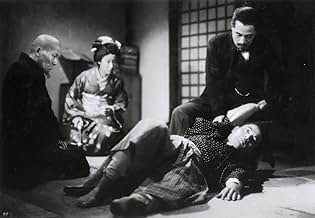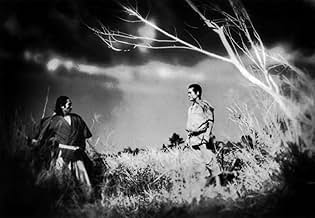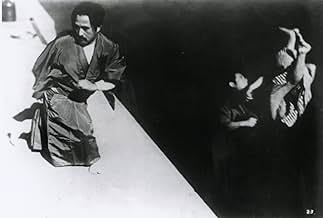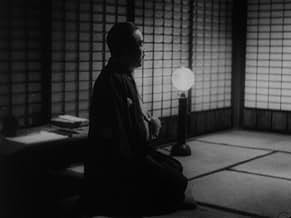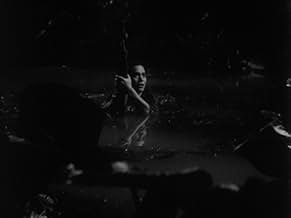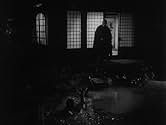Ajouter une intrigue dans votre langueSugata, a young man, struggles to learn the nuance and meaning of judo, and in doing so comes to learn something of the meaning of life.Sugata, a young man, struggles to learn the nuance and meaning of judo, and in doing so comes to learn something of the meaning of life.Sugata, a young man, struggles to learn the nuance and meaning of judo, and in doing so comes to learn something of the meaning of life.
- Réalisation
- Scénario
- Casting principal
- Hatta
- (as Michisaburo Segawa)
- Monma's pupil
- (non crédité)
Avis à la une
According to a very interesting online article by Walter Klinger, the film was submitted to two distinct forms of censorship. First of all, during production, from government censors urging Kurosawa to make a film glorifying Japanese warriors and their spirit of devotion to "chuukou", i.e. "loyalty and devotion" understood as an infallible principle requiring absolute loyalty to one's superiors and blind obedience to orders (a principle that made Kamikaze pilots possible). In the pond scene, Sanshirô's master urges him to follow "chuukou" and after his nighttime revelation, Sanshirô bows obediently to his master.
In the post-war period, all references to this principle were outlawed by the General Headquarters of the Supreme Commander for the Allied Forces (SCAF - the occupying Americans) as an anti-social remnant of Japanese feudalism which was perceived as the root cause of Japan's stubborn refusal to surrender. Not only was the "chuukou" word excised from that scene in mid-sentence (and never put back in, even in the "restored" version) but all subsequent editions of the novel the film was based on, even in animé or manga form or in film remakes and sequels, were also excised for the same reason, which means that the hero was reduced to finding "satori" in other more universal Zen sources or nuanced feelings, such as the love of his beloved, the realization of his own selfishness or respect for his master.
As post-war young Japanese people weren't particularly fond of "chuukou" to begin with, especially as it concerned blind devotion to tradition and unconditional loyalty to one's parents (or employers), this was not seen as a major problem.
The SCAF, however, also outlawed scenes of feudal loyalty, cruel violence and the "undemocratic idea of revenge", "feudal" commodities for which the Japanese public never really lost its tremendous appetite, and which eventually became the main themes of Yakuza, samurai and martial arts films. Furthermore, martial arts, including judo, with their stigma of "warrior's ways" and "blind obeisance", were also banned from government-sponsored settings like schools and police departments, until 1950, at the very time when they were conquering the rest of the civilized world, including America.
Based on a best-selling novel, Sugata Sanshiro established the reputation of Kurosawa, and made him a prominent figure in the filmmaking business. Though it's far from being a genuine masterpiece, the film still shows the director's steady hand and is the admirable proof of his awe-inspiring versatility.
To become the master of martial arts is an uneasy task, and Sanshiro learns the lesson in the first minutes of the picture. Trying to join a clan of Jujitsu fanatics, he quickly realizes that they're just a bunch of up to no good coxcombs. Seeing how easily Yano (Denjirô Ôkôchi), the originator and master of Judo, defeated the group, Sanshiro decides to become his student. To become a proficient Judo technician the young, strong-willed, yet somehow reckless Sugata must overcome many of his weaknesses and find out the meaning of a warrior's way, thus learning the true meaning of life. The student, struggling to accustom himself to the situation, is constantly tested by his master, in many more or less laborious ways. And when the time comes, Sanshiro is finally able to take part in tournaments, in order to prove his indisputable technique and unrestrained power. On his way Sanshiro meets a mysterious, elegant, devilish man by the name of Hagaki (Ryûnosuke Tsukigata), who's like a shadow that's been following Sugata everywhere that he goes. Ironically so, the man - with his familiar look and specifically evil attitude - comes as a typical dark character, taken straight out of a superhero movie. In the film's most climatic and disquieting sequence, the two rivals participate in a duel that will determine who's the strongest living martial artist.
For all the lovers of Japanese culture, and for all the adepts of Asian martial arts, Sugata Sanshiro will definitely be a worthy film experience. For the rest it might be an insightful, valuable, and well-crafted period drama that's not only full of perfectly choreographed action scenes, but also full of humane qualities that prove to have an authentic meaning even in the modern times.
The outstanding, mind-blowing camera-work that Kurosawa is known for is in a huge development process here, on account of this being his first work; however, even though not yet in a full-fledged form, everything that is meant to be portrayed comes through wonderfully. The story is another factor that definitely enhances the representation taking place in the film, as it matches perfectly with the cinematic techniques Kurosawa puts to work. If there are any inconveniences to be encountered throughout the course of the film, it would all obviously be as a result of the cut-off already mentioned.
The conspicuous acting goes without saying; everyone in the film fits into their roll perfectly. The main character may probably come as overacted to an audience not familiarized with Kurosawa's work, or Japanese cinema for that matter; Susuma Fujita would not be as well-known as Toshiro Mifune would later become, but he undoubtedly does his best here.
The film, despite the cut-off, works perfectly. One can just wonder how much better this could be if it were in its full form, as first conceived by the director.
Having said that, you will find this to be one of Kurasawa's most interesting projects. Two things...
One is that this was made by the bad guys during the war. Incredible atrocities were being committed in the name of racial superiority and the supposition of a refined nobility. Japanese, German and American films (even Italian ones) turned to reinforcing the national character. In the Japanese case, that was linked to matters of honor refracted through Shinto spirituality, honor of a past ideal that never really existed, which in US terms means what "conservatives" tout.
It was a terrible exercise, more obvious in looking at it from the outside and knowing the context. Kurosawa's story was every bit as engineered for this purpose as any Reifenstahl project. Oddly, this film is fragmented because the sensors thought it not ennobling enough. One presumes that Kurosawa's moments of reflection, and possibly a whole love story, were among the half of the movie that was removed. So just on the level of the story itself (a modernized samurai tale), its of interest.
But it IS Kurasawa, so we have to pay attention to the way the camera engages with the space. This is his very first film as director, though he had written before. In all his films he registers the camera first in a space and then allows action to happen in that space. He has three periods of different types of spatial identity, each illuminating, each inventing new language. But this is before all that and what we have is clear, overt experimentation with space. Some of it is quite thrilling, quite independent of the fascist movement of the story proper.
Even here, he is breaking the rules of flat Japanese composition from eons of painting. He was considered unJapanese in his native country and never very popular. So at the same time that those censors were chopping story and posture they must have been shaking their heads at this three dimensional art, and wondering if they had already lost the war and if they won, what for?
Ted's Evaluation -- 3 of 3: Worth watching.
Le saviez-vous
- AnecdotesWhen asked about his experience filming his debut movie, Akira Kurosawa said "I simply enjoyed it. I went to sleep each night looking forward eagerly to the next day's shooting, and there was absolutely nothing painful in the experience... the whole task was carried out with a feeling of ease."
- Citations
Sanshiro Sugata: The spirits of heaven and earth congregate in our nation of gods. For us they have built Mt. Fuji that towers for eternity. For us they have brought water to flow around our islands. For us they have created the beauty of cherry blossoms...
[he stops and remembers Sayo]
Buddhist Priest: [hits Sanshiro on the head] Idiot! This is an important match. What the hell are you thinking?
Sanshiro Sugata: I can't do it. I can't win.
Buddhist Priest: What? Are you afraid of Hansuke Murai?
Sanshiro Sugata: No. Someone stands between him and me.
Buddhist Priest: Who?
Sanshiro Sugata: His daughter.
Buddhist Priest: You love her?
Sanshiro Sugata: No. It's not that. Priest, I saw her praying selflessly for her father. It was beautiful and I was touched. That's the problem. How can I overcome it?
Buddhist Priest: Stupid! Be pure and innocent like her.
Sanshiro Sugata: I can't.
Buddhist Priest: You can. You once were.
Sanshiro Sugata: When?
Buddhist Priest: [pointing to the pond] Sanshiro Sugata found new life there. Have you forgotten? What is your life, Sanshiro?
- Versions alternativesAlthough originally released in Japan at 97 minutes, it was re-edited and re-released in Japan in 1952 at 80 minutes. This 80-minute version is all that is currently available, and it includes some slight changes in the film's structure as well as its running time.
- ConnexionsFeatured in Kurosawa: The Last Emperor (1999)
Meilleurs choix
- How long is Sanshiro Sugata?Alimenté par Alexa
Détails
- Durée1 heure 19 minutes
- Couleur
- Mixage
- Rapport de forme
- 1.37 : 1
Contribuer à cette page


